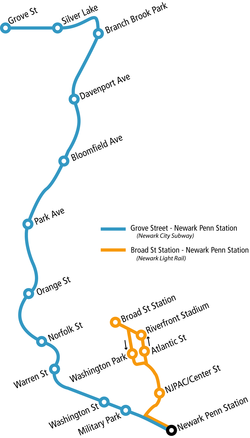Newark Light Rail
| Newark Light Rail | |||
|---|---|---|---|
standard gauge | |||
| Minimum radius | 33 ft (10.058 m)[5] | ||
| Electrification | Overhead line, 750 V DC | ||
| Operating speed | 50 mph (80 km/h) | ||
| |||
The Newark Light Rail (NLR) is a
Newark City Subway
The Newark City Subway is the longer and older of the two segments.[8] It is a "subway–surface" line[9] which runs underground from Penn Station to Warren Street, and above-ground north of Warren Street. Before becoming a part of the Newark Light Rail service, it was also known as the #7-City Subway line, an NJT Bus Operations route number carried over from its days when it was part of Public Service's Transport of New Jersey subsidiary. The number still applies internally. During subway system closures, replacement buses would also bear the route number "7 City Subway".
The segment is 5.3 mi (8.5 km) long and runs between Grove Street in
History
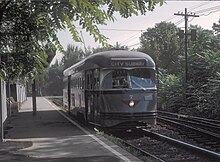
The line opened in 1935 along the old
Operation of the complete subway to the newly built Penn Station was delayed until 1937. The terminal below Penn Station has five tracks, two incoming and three outgoing, connected by two loop tracks. This part of the subway included a grade-separated junction with a connection to the lower level of the Newark Public Service Terminal that was used for only a few months (June to September).
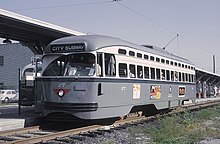
An extension to a wooden station at North 6th Street or Franklin Avenue was opened in 1940, located north of the present Branch Brook Park station. In 1953 the line was cut back about one block to accommodate construction of a turning loop, and a new station, still called Franklin Avenue, was opened adjacent to Anthony Street. The station was enlarged in 2002 and renamed Branch Brook Park.
The subway was operated by Transport of New Jersey (formerly Public Service Coordinated Transport) as its No. 7 line. Other streetcar routes used parts of the subway, reaching street trackage at the locations shown below, ending as each route was closed and replaced by bus service:
- Cedar Street Subway), 1937 only: #13 Broad, #17 Paterson, #27 Mount Prospect, #43 Jersey City
- Warren Street ramp, 1935–1951: #21 Orange—West Orange via Market Street
- Central Avenue ramp, 1935–1947: #23 Central
- Orange Street crossing, 1935–1952: #21 Orange—West Orange via Orange Street
- Bloomfield Avenue ramp, 1935–1952: #29 Bloomfield
Until June 5, 1952, the
Starting in January 1954, 30
In 2001, new light rail cars built by Kinki Sharyo in Japan in 1999 replaced the PCCs. The last day of PCC service was August 24, 2001.[11]

Some of the PCCs are stored in the Newark City Subway shop. Eleven were sold in 2004 to the San Francisco Municipal Railway for use on its F Market heritage streetcar line.[12] One PCC, #15, was delivered to the Connecticut Trolley Museum in 2013 for restoration and display. One of the Shaker Heights cars has been restored by the Minnesota Transportation Museum, which operates it on a short stretch of track in western Minneapolis.
In 2005, eight PCCs were given to the City of
On September 4, 2004, Broad Street Station was renamed Military Park Station, to avoid confusion with the terminal of the new route to the
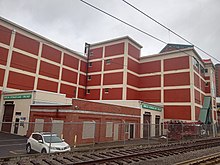
Bloomfield extension
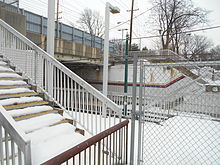
On June 22, 2002, the Newark City Subway was extended to the suburbs of
The original agreement gave sole operating privileges to Norfolk Southern between 11 pm and 5 am daily, but a new agreement allows passenger service to operate at all hours, with late-night service commencing on January 8, 2005. In exchange, Norfolk Southern can now operate during all off-peak hours, when passenger trains are infrequent.
Broad Street Extension
The Broad Street Extension is the second segment of the Newark Light Rail. It was planned as the first phase of the
A new tunnel leads from the junction to a portal about two blocks north. The remaining section runs above ground. For a few blocks, the two tracks run on different streets a block or two apart. Both tracks serve the
Construction began in 2002 with an estimated cost of $207.7 million, or about $40,000 per foot of track;[18] it was completed within budget.[19] Projections were for 4,000 average weekday boardings after one year, growing to about 7,000 in 2010. Actual weekday boardings in 2010 for both Newark Light Rail lines combined were reported at 9,000.[20]
The art work at the new stations has a common theme, "Riding with Sarah and Wayne." It is a tribute to Newark-born jazz greats
The Broad Street Extension was intended to ease connections between Newark's two rail stations. The two separate stations are a legacy of their roots in two separate railroads. Broad Street Station was once owned by the Lackawanna Railroad and its successor, the Erie Lackawanna Railway, while Penn Station was built and owned by the Pennsylvania Railroad. Previously, passengers wanting to transfer between Amtrak and the former PRR/Conrail commuter lines and the former (Erie) Lackawanna commuter lines had to make their own way (usually by taxi or bus) between the two stations.
Fares
The Newark Light Rail is equivalent to a one-zone bus ride: a one-way ticket costs $1.60 (as of October 1, 2015), and is valid for one hour on the entire system from the time the ticket is validated. A special $0.75 "Underground" fare is available for trips that use the subway only between Warren Street and Penn Station and not the surface portion. Through-ticketing is available for connecting bus routes. Monthly and weekly NJ Transit bus and rail passes valid for one or more local bus zones, as well as transfers purchased on buses, are also accepted.[21]

The Newark Light Rail, like most light rail systems in the United States, operates on a
Stations
Newark Light Rail | ||||||||||||||||||||||||||||||||||||||||||||||||||||||||||||||||||||||||||||||||||||||||||||||||||||||||||||||||||||||||||||||||||||||||||||||||||||||||||||||||||||||||||||||||||||||||||||||||||||||||||||||||||||||||||||||||||||||||||||||||||||||||||||||
|---|---|---|---|---|---|---|---|---|---|---|---|---|---|---|---|---|---|---|---|---|---|---|---|---|---|---|---|---|---|---|---|---|---|---|---|---|---|---|---|---|---|---|---|---|---|---|---|---|---|---|---|---|---|---|---|---|---|---|---|---|---|---|---|---|---|---|---|---|---|---|---|---|---|---|---|---|---|---|---|---|---|---|---|---|---|---|---|---|---|---|---|---|---|---|---|---|---|---|---|---|---|---|---|---|---|---|---|---|---|---|---|---|---|---|---|---|---|---|---|---|---|---|---|---|---|---|---|---|---|---|---|---|---|---|---|---|---|---|---|---|---|---|---|---|---|---|---|---|---|---|---|---|---|---|---|---|---|---|---|---|---|---|---|---|---|---|---|---|---|---|---|---|---|---|---|---|---|---|---|---|---|---|---|---|---|---|---|---|---|---|---|---|---|---|---|---|---|---|---|---|---|---|---|---|---|---|---|---|---|---|---|---|---|---|---|---|---|---|---|---|---|---|---|---|---|---|---|---|---|---|---|---|---|---|---|---|---|---|---|---|---|---|---|---|---|---|---|---|---|---|---|---|---|---|
| ||||||||||||||||||||||||||||||||||||||||||||||||||||||||||||||||||||||||||||||||||||||||||||||||||||||||||||||||||||||||||||||||||||||||||||||||||||||||||||||||||||||||||||||||||||||||||||||||||||||||||||||||||||||||||||||||||||||||||||||||||||||||||||||
Key
| ||||||||||||||||||||||||||||||||||||||||||||||||||||||||||||||||||||||||||||||||||||||||||||||||||||||||||||||||||||||||||||||||||||||||||||||||||||||||||||||||||||||||||||||||||||||||||||||||||||||||||||||||||||||||||||||||||||||||||||||||||||||||||||||
| ||||||||||||||||||||||||||||||||||||||||||||||||||||||||||||||||||||||||||||||||||||||||||||||||||||||||||||||||||||||||||||||||||||||||||||||||||||||||||||||||||||||||||||||||||||||||||||||||||||||||||||||||||||||||||||||||||||||||||||||||||||||||||||||
Newark City Subway
| Location | Station | Opened | Closed | Transfers | Notes |
|---|---|---|---|---|---|
| Newark | Penn Station | June 20, 1937 | Buses: PATH trains to Jersey City, Hoboken, New York City, Amtrak to Philadelphia and points south, and New York Penn Station and points north
|
||
| Military Park | May 26, 1935[23] | NJ Transit buses: 108 ONE Bus: 24, 44 |
Formerly Broad Street until September 4, 2004;[24] served the Newark Public Service Terminal | ||
| Washington Street | NJ Transit buses: 11, 28, 29, 70, 72, 76, and 78 ; ONE Bus: 44 (inbound only)
|
||||
| Warren Street/NJIT | NJ Transit buses: 71, 73, and 79
|
The station was renamed in 2011 to Warren Street/NJIT from Warren Street.[25] | |||
| Norfolk Street | NJ Transit buses: 99 ONE Bus: 24, 44 |
||||
| Orange Street | NJ Transit buses: 71, 73, 75
|
||||
| Park Avenue | NJ Transit buses: 41
|
||||
Bloomfield Avenue
|
NJ Transit buses: 11, 28, 29, 72
|
||||
| Davenport Avenue | |||||
Heller Parkway
|
May 26, 1935[23] | June 21, 2002[26] | Closed for consolidation with Franklin Avenue station by Branch Brook Park.[26] | ||
| Branch Brook Park | November 22, 1940[27] | NJ Transit buses: 27, 74, 90, 92, 99
|
Formerly known as North Sixth Street and Franklin Avenue, the latter until August 27, 2001.[28] | ||
| Belleville | Silver Lake | June 22, 2002[26] | NJ Transit buses: 27, 90
|
||
| Bloomfield | Grove Street | NJ Transit buses: 11, 28, 29, 72, 90
|
Broad Street Extension
All stations are in Newark.
| Station | Opened | Transfers | Notes |
|---|---|---|---|
| Penn Station | June 20, 1937 | Buses: PATH trains to Jersey City, Hoboken, New York City, Amtrak to Philadelphia and points south, and New York Penn Station and points north
|
|
| NJPAC/Center Street | July 17, 2006[29] | ||
| Line splits into one-way directions | |||
Harriet Tubman Square
|
July 17, 2006[29] | NJ Transit buses: 11, 13, 27, 28, 29, 39, 41, 59
|
Southbound-only stop |
Atlantic Street
|
Northbound-only stop | ||
| Riverfront Stadium | |||
| Lines re-converge entering Broad Street | |||
Broad Street
|
July 17, 2006[29] | NJ Transit buses: | |
On weekdays, service operates separately between the two sections. On weekends, service operates jointly.
Rolling stock
The Newark Light Rail system uses a new-model vehicle built by
The Seashore Trolley Museum in Kennebunkport, ME acquired PCC #5 in 2011.[31] The car represents the first piece of NJT rolling stock in the museum's collection. The car is currently undergoing restoration and rehabilitation work so that it may operate on the museum's 1+1⁄2-mile demonstration railway. Car #5 joins the museum's already-extensive collection of PCC cars from numerous cities, including Boston, Pittsburgh, Dallas, San Francisco, Philadelphia, Washington, D.C., and Kansas CIty.
Timeline
- December 22, 1910: The Public Service Corporation first announces plans to build the subway, initially including a line under Broad Street from Bridge Street to Clinton Avenue[32]
- October 3, 1934: The subway opens from Broad Street to Heller Parkway.[27] The No. 21 line is routed onto the subway via the Warren Street Ramp and level junction at the Orange Street grade crossing. The No. 23 line is routed via the Norfolk Street Ramp. The No. 29 line starts using the Bloomfield Avenue Ramp.
- June 20, 1937: The extension to Newark Penn Station opens. This is the same day that the Hudson and Manhattan Railroad (present-day Cedar Street Subway; the No. 27 and No. 43 had used the lower level of the Newark Public Service Terminal.
- June 21, 1937: The No. 17 line is rerouted via the Cedar Street Subway.
- July 18, 1937: The No. 13 and No. 17 lines stop using the Cedar Street Subway.
- December 29, 1937: The No. 27 line stops using the Cedar Street Subway.
- May 1, 1938: The No. 43 line stops using the Cedar Street Subway, ending all service on that connection.
- November 22, 1940: The extension to North 6th Street (later Franklin Avenue) opens.
- December 14, 1947: The No. 23 line stops using the Norfolk Street Ramp.
- March 1, 1951: The No. 21 line stops using the Warren Street Ramp.
- March 29, 1952: The No. 21 line stops using the level junction at the Orange Street grade crossing.
- March 30, 1952: The No. 29 line stops using the Bloomfield Avenue ramps.
- January 8, 1954: The first PCC car uses the subway.
- October 1980: NJ Transit takes over operations.
- August 21, 1999: The subway is closed for two weeks for an overhaul.
- September 7, 1999: The subway reopens.
- August 24, 2001: The PCC cars are retired from service.[17]
- August 27, 2001: The new light rail vehicles begin operation.[33]
- June 21, 2002: Heller Parkway closes.[34]
- June 22, 2002: Silver Lake and Grove Street open.[34]
- September 4, 2004: Broad Street is renamed Military Park.[24]
- January 8, 2005: Additional late-night service is provided to Grove Street.[35]
- July 17, 2006: The Newark City Subway extension opens, with service between Newark Broad Street. Service is rebranded as the Newark Light Rail.
Accidents
The Newark City Subway has had a few accidents over the years:
- September 22, 1981 – Nine passengers injured when an incoming trolley rammed into the rear of a stationary trolley at Newark Penn Station.[36]
- April 15, 2003 – A light rail vehicle was partially derailed at the grade crossing near Orange Street Station when a box truck rammed the vehicle from the side. The signal was in the light rail vehicle's favor.[37]
- August 23, 2008 – A dump truck making an illegal right turn crashed into a light rail vehicle at the Washington Park Station of the Broad Street segment causing it to partially derail. One passenger was injured.[citation needed]
- August 28, 2014 – A light rail vehicle crashed into a SUV between Atlantic Avenue and Broad Street. No passengers were injured.[38]
- April 6, 2016 – A light rail vehicle was hit by a car on South Franklin Avenue. No passengers were injured.[39]
In popular culture
- In November 2011 scenes for the movie Military Park station.[40]
See also
- Hudson–Bergen Light Rail
- River Line
- Light rail in the United States
- List of tram and light rail transit systems
References
- ^ "NJ Transit Facts At a Glance Fiscal Year 2019" (PDF). NJ Transit. July 2018. Archived from the original (PDF) on November 26, 2019. Retrieved November 5, 2019.
- ^ Pirmann, David & Darlington, Peggy (2012). "world.nycsubway.org: Newark, New Jersey Light Rail/City Subway". nycsubway.org. David Pirmann.
- ^ a b c "Newark light rail set to open july 17". NJ Transit. June 22, 2006. Archived from the original on May 21, 2013. Retrieved August 7, 2013.
- ^ "NJ Transit Facts At a Glance Fiscal Year 2014" (PDF). NJ Transit. March 2015. Archived from the original (PDF) on September 6, 2015. Retrieved April 2, 2015.
- ^ On line pubs TRANSPORTATION RESEARCH BOARD EXECUTIVE COMMITTEE 1995]
- ^ "Newark Light Rail" (PDF). New Jersey Transit. August 2008. Archived from the original (PDF map) on March 3, 2016. Retrieved September 6, 2015.
- New Jersey Transit. January 2014. Archived from the original(PDF map) on July 24, 2014. Retrieved September 6, 2015.
- ^ See Riley, John Harrington, "The Newark City Subway Lines," (1987). This scarce book, which covers the history of the subway lines and the predecessor horse and trolley lines, is occasionally available on Amazon.
- ^ John W. Schuman; n, Louis T. Klauder (1978). "Evaluations of Operating Light-Rail Transit and Streetcar Systems in the United States". TRB Special Report. 182 (Light Rail Transit: Planning & Technology): 94.
- ^ "Light Rail Spurs New Development". NJDOT.org. Retrieved September 23, 2023.
- ^ "Farewell to Newark PCCs" (October 2001). Tramways & Urban Transit, p. 386. Ian Allan Publishing.
- ^ "Historic Streetcars in San Francisco". Market Street Railway. Retrieved April 1, 2013.
- ^ Peninsula at Bayonne Harbor development plan Archived June 20, 2007, at the Wayback Machine, page 17, accessed July 25, 2006
- ^ Staff. "Subway extension to open in summer, Newark officials hope that the $207.7 million downtown project will help spur a renaissance.", The Philadelphia Inquirer, February 13, 2006. Accessed July 18, 2011. "The last major expansion of the 4.3 mile subway in 2002 brought the service into the neighboring cities of Belleville and Bloomfield."
- ^ Jacobs, Andrew (October 18, 2000). "Paths of Transit: Once Forgotten, Bound for Duty; Sealed Tunnels Unearthed for Rail System in Newark". The New York Times.
- ^ "Capital Improvement Program - System Expansion Projects - Extension of the Newark Light Rail (NLR) to Newark Broad Street Station". NJ Transit. August 2006. Retrieved August 7, 2013.
- ^ a b Klufas, Michael (August 24, 2001). "NJ TRANSIT OFFICIALS, CUSTOMERS, TROLLEY ENTHUSIASTS SAY GOODBYE TO NEWARK CITY SUBWAY'S PCC CARS - New Light Rail Vehicles to Begin Service August 27". NJ Transit. Archived from the original on September 30, 2007. Retrieved September 6, 2015. Press Release 323.
- ^ NJ TRANSIT Department of Capital Planning and Programs. "Extension of the Newark Light Rail (NLR) to Newark Broad Street Station". NJ Transit. Archived from the original on June 17, 2009. Retrieved September 6, 2015. Project 005.
- ^ Stessel, Dan (July 17, 2006). "NEWARK LIGHT RAIL OPENS TO SUPPORT CITY'S ECONOMIC REVITALIZATION - Connects Newark's two train stations through business district". Archived from the original on September 27, 2007. Retrieved September 6, 2015. Press Release NJT-06-092, ID 2246.
- ^ New Jersey Transit. Njtransit.com. Retrieved on June 23, 2014.
- ^ "Newark Light Rail" (PDF). New Jersey Transit. April 7, 2018. Retrieved December 19, 2018.
- ^ "Light Rail Tickets". New Jersey Transit. Retrieved August 27, 2022.
- ^
- ^ a b "Customer Notice - Newark City Subway Broad Street Station Renamed Military Park Station". NJ Transit. Archived from the original on September 27, 2007. Retrieved September 6, 2015. Customer Notice 1227.
- ^ Heyboer, Kelly (March 4, 2011). "Warren Street stop on Newark Subway line to get $40K makeover with help of NJIT student". The Star-Ledger. Retrieved March 5, 2011.
- ^ a b c "Two New Stations to Open on the Newark City Subway". New Jersey Transit (Press release). Newark, New Jersey. June 18, 2002. Retrieved January 15, 2020.
- ^ a b "UrbanRail.Net > North America > USA > New Jersey > Newark City Subway, PATH and Hudson-Bergen Light Rail".
- ^ a b c "Broad Street Extension of Newark Light Rail Celebrates 10 Years". New Jersey Transit (Press release). Newark, New Jersey. July 18, 2016. Retrieved January 15, 2020.
- ^ Douglas John Bowen (July 9, 2014). "NJT OKs LRV add-ons - Railway Age". railwayage.com.
- ^ Seashore Trolley Museum: Browse the Collection. Trolleymuseum.org. Retrieved on June 23, 2014.
- ^ "Plan Newark Subway". The New York Times. December 23, 1910.
- ^ Klufas, Michael (August 27, 2001). ""NEW" NEWARK CITY SUBWAY DEBUTS - Smooth, Air-Conditioned Light Rail Vehicles Carry Customers in 21st Century Comfort". NJ Transit. Archived from the original on September 27, 2007. Retrieved September 6, 2015. Press Release 326.
- ^ a b "TWO NEW STATIONS TO OPEN ON THE NEWARK CITY SUBWAY - Expanded Service Begins/Weekend Service Resumes on June 22". NJ Transit. June 18, 2002. Archived from the original on September 30, 2007. Retrieved September 6, 2015. Press Release 510.
- ^ "NEWARK CITY SUBWAY EXTENDS LATE NIGHT SERVICE, IMPROVES EFFICIENCY - Extra 2 hours of service to Grove Street begins January 8". NJ Transit. December 29, 2004. Archived from the original on November 13, 2006. Retrieved September 6, 2015. Press release NJT-04-084.
- ^ "Subway Crash Hurts 9 at Terminal in Newark". The New York Times. September 22, 1981. Retrieved July 20, 2011.
- ^ "Truck slams into Newark subway train". Star-Ledger. Newark. April 16, 2003.
- ^ Mazzola, Jessica (August 28, 2014). "Service delayed after NJ Transit light rail, SUV crash in Newark". NJ.com.
- ^ "No one hurt after car strikes Newark Light Rail". WABC. April 6, 2016.
- ^ Mike Frassinelli (February 10, 2013). "Holy subway, Batman! A hidden world of clean, on-time riding exists beneath Newark". The Star-Ledger. Retrieved May 17, 2013.
- Bibliography
- Edward Hamm, Jr., The Public Service Trolley Lines in New Jersey.
- DOT Docket FRA-2000-7335-7 and −8.

